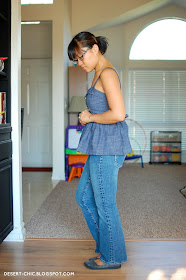My love affair with this
pinafore pattern by Laurie Case continues (see
post #1 and
post #2). I made these for a 2-year-old's birthday and a baby shower. It will be the same party since the girls are going to be sisters and the family decided to couple the celebrations together.
I wasn't joking about the "GALORE" part of the post title. (Alternate title: "I'm Sorry I Don't Have Outfit or Shoe Posts. I'm Busy Sewing.") This was my first attempt at "mass" production, 4 reversible pinafores at the same time ... which really means I made 8 pinafores, right? Behold:
Amazingly, I was able to make all the pinafores in one day (it was a long day). Amazing because not only were they all different sizes (6M, 12M, 2T, and 3T), but they were also different fabrics and colors. Luckily, I was able to use the same color thread for all of them most the time since the thread wouldn't be seen. (No topstitches until the very end.) I did each step with the 8 pieces of fabric, from first cutting out the patterns to topstitching the pinafores closed at the end.
(I know I'm patting myself on the back here, but I am impressed -- and surprised -- that I managed to do it. :-D )
All pattern pieces cut and ready for sewing to begin
All 4 pinafores pinned and ready for machining
Process notes:
Now that I've made 5 out of the 7 available sizes (I haven't yet made an 18M or 5/6 size), I want to be more detailed in my review of this pattern in case you wanted to give it a try. I should note that the
patterns are pretty affordable: you can get each size pattern (as a PDF) for $2, or you can get all 7 for $10. I did mine kind of piecemeal since I purchased 6 kits on sale (each of which includes pre-washed fabrics and the pattern size of your choice -- a great deal especially if you like the available fabrics) and just spent 2 bucks on the last pattern size.
Anyway, on to my notes on the pattern. First, be careful when taping together the printouts from the PDF files. Each pattern size is hand-drawn. The instructions say not to overlap your sheets of paper and just attach them edge-to-edge. Don't follow those instructions. You'll see why when you match the sheets together and the lines don't match up most of the time. What's most important is that when you put together the front piece and then the back piece, the pinafore's side edges have to match in length. The 2T size was particularly problematic, but if you know what the end product is supposed to look like, you can edit the pattern as needed.

Second, it's helpful to use a binder clip (or multiple clips) to keep all the layers of fabric together once you start cutting. I don't remember where I found this tip, but now I'm passing it on to you. It works beautifully. Other helpful tools: tailor's/dressmaker's chalk to trace out the pattern onto the fabric, rotary cutter (used with a self-healing cutting mat), and pattern weights.
Third, when sewing the shoulders together, remember to match up the fabric where the stitch line is supposed to be (in most of the cases it's at 5/8" since that's the seam allowance). It's OK if the actual edges of the shoulders don't match each other.
If you're going to make multiple pinafores like I did, or if you just want to speed up the process a little when making one,
use the chain piecing method for the shoulders.
The hardest part about this pinafore pattern is at the end, when you're supposed to connect the sides of the pinafore by invisible-sewing one layer closed, then close up the whole thing by turning it over and topstitching through all the layers. These steps require extra care and that's when you want to watch Laurie Case's brief video explanation (link provided upon purchase of the pattern). The problem with connecting the sides is very similar to my problem with trying to hem too-narrow leg- or armholes. There really is no help for it in this case, however; just be careful and go slowly as needed. You don't want to accidentally sew puckers into the seams. And in my case pins kept popping out as I sewed so I needed to make sure that the edges were aligned at all times. Yes this can definitely be frustrating.

In the topstitching step, it's a good idea to match the right color thread with the fabrics. When you decide which side to close invisibly and which side to topstitch, you should have an idea of which side would require very neat topstitching and so then invisibly close the other side first. In the case below, with the ocean fabric and black fabric with white polka dots, I chose the black/polka dot fabric to invisibly close first so that the ocean fabric would have the neat topstitching. Then I turned it over and pressed carefully, made sure that my top thread was white and my bobbin/bottom thread was black, and edgestitched as neatly as I could (I used the slowest setting on my machine). This particular seam turned out to be the best one in the bunch:
This one is an example of a topstitch seam that didn't turn out that great on the other side (it doesn't look edgestitched), but overall it was fine, and if I didn't think so I would have ripped those seams out, trust me:
Well, those are my thoughts on this pattern. I hope any of this was helpful to you. Happy sewing!
xo, Gladys




























































